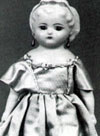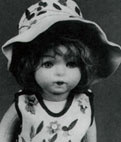 8 1/2"All-Bisque Child/Kestner 150
8 1/2"All-Bisque Child/Kestner 150
H&J Foulke, Inc.
Bisque:
Bisque is
one of the most popular types of dolls. From 1860-70's most of the
bisque heads were put on lady dolls. The all-bisque
dolls generally represented children. They were produced in Europe,
a few in America and Japan. At the Paris Exhibition of 1878, Emile
Jumeau showed his French "Bebes Incassable", child dolls with bisque heads
on fully jointed composition bodies. A few of this type were recorded
as early as 1876. Then Germany began marketing their versions.
As competion increased, prices dropped. New methods were developed
such as pouring the slip instead of 'pressing' it.
 17"
Sonneberg-type papier-mache with molded hair
17"
Sonneberg-type papier-mache with molded hair
H&J Foulke, Inc.
Carton
Dolls:
In
the late 1700's bread dough dolls were made by pressing a mass of paper
into a mold and letting it harden. Then it was covered with dough
and molded. Carton (Carton Moule) French terms for a kind of
papier-mache. At first these dolls had their head and torso of carton.
Later developed into the French papier-mache heads on kid bodies.
 11"
composition/Kewpie
11"
composition/Kewpie
H&J Foulke, Inc.
Cold-Press
Composition:
1890's-1929.
Benjamin Goldenberg and Otto Denivelle were credited with the improvements
of, Solomon D. Hoffmann's Cold-Press Composition. The problems
of peeling were never completely resolved. Containing glycerin, flour,
etc. the soupy mixture was poured into plaster molds. Limbs
were made by the same process as the heads. The product was heavy
and tended to soften in the warm weather.
 14" Worsted Doll/Horsman
14" Worsted Doll/Horsman
Internation Doll Library/Photo by Sotheby Parke
Bernet Inc., NY
Worsted
Dolls:
In
the 1880's onward, Worsted Dolls (Woolen), were commercially
produced. These dolls had stockinette faces and worsted hair.
Their clothes were crocheted or knitted. Usually cloth features were
used on the faces, with buttons, or beads for their eyes. Often the
bodies were made of woven fabrics.
 13"
Celluloid Doll/ Parsons-Jackson toddler with molded shoes and socks
13"
Celluloid Doll/ Parsons-Jackson toddler with molded shoes and socks
H&J Foulke, Inc.
Celluloid:
Most
of the celluloid dolls were made in Germany, but were painted in Italy.
Rheinische Gummi und Celluloid Fabrik registered the Turtle tradmark as
early as 1899. "Toys and Novelties", reported that before 1910 D.
Harmonica perfected the making of pyroxylin plastic toys by the blowing
method, about the same time as Rheinische Gummi und Celluloid Fabrik.
After years of dispute, both were given the right to produce celluloid
toys. The all-celluloid dolls had either straight or bent limbs.
Generally the hair was molded, and even clothes. Occansionally larger
dolls had wigs.
Wooden
Dolls:
Wood
has been used for commercial, folk art, and homemade one of a kind dolls.
Because of it's ease in carving 'Basswood" (linden wood), was a favorite.
The dolls have been made in The American West, England, Kentucky Mountain
area, Russia, Switzerland, Greenland, and Wales as well as other places.
 12" Wax-over-composition girl with molded hair
12" Wax-over-composition girl with molded hair
H&J Foulke, Inc.
Wax
Dolls:
Ancient
times to present people have crafted wax dolls. These perishable,
but popular dolls were often expensive and artistic. The wax dolls
from Paris melted in the summer heat at the 1876 Philadelphia Centennial
Exhibition. The wax-over-composition dolls were usually less attractive,
less expensive and more durable than the wax dolls.
 18"
Meatal Head Doll/Minerva mark
18"
Meatal Head Doll/Minerva mark
H&J Foulke, Inc.
Metal
Dolls:
Numerous
dolls were made with the metal heads, or were all metal. The
all-metal mechanical toys are not considered to be dolls. One of
the earliest metal-head dolls had molded hairdo with a braided bun and
comb on back. This lead colored metal head was painted and affixed
to a kid body with wooden arms and legs. Thus the dolls closely resembled
the early molded hair papier-mache head dolls. The chief manufacturing
center of metal heads was Germany. The heads were stamped out of
sheet metal and the two halves were welded together.
 16" Felt/Lenci-type child with glass eyes
16" Felt/Lenci-type child with glass eyes
H&J Foulke, Inc.
Cloth
Dolls:
Cloth
dolls are varied in sizes shapes and forms. I'm sure we all remember
the rag dolls, probably the earliest playtoy for most children. Cloth
dolls have been popular throughout historical times. They were made
in many forms from front and back with two pieces of cloth sewn together
to sophisticated types with three dimensional molded and needle sculpted
features. Often they were made at home. Many imprtant doll
manufacturers included a line of cloth dolls. The artistic felt dolls
were among the most expensive dolls of the 1920's. Cloth dolls 1920-30's
by Dorothy Heizer originally cost several hundred dollars. In 1882
Butterick issued it's first pattern for making a cloth doll. In 1913
TOYS AND NOVELTIES reported; "The indestructable rag baby is wholly American
and is manufactured in many large cities. A few of these have been
exported but they have not proved very popluar with the European child."
|
|
|
|
|
|
|
|
|
|
|
|
